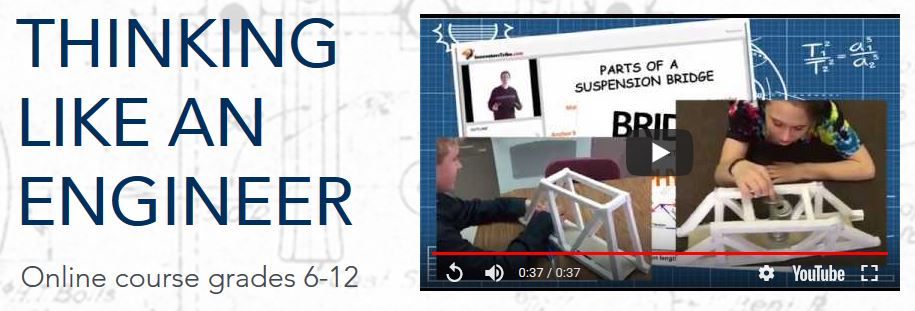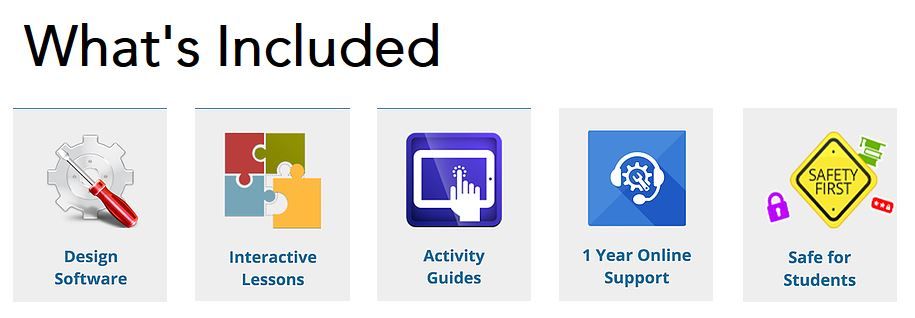When my oldest child heard about an opportunity to review Thinking Like an Engineer from Innovators Tribe, he was excited to get started with it. Self-paced, independent, online, and with an opportunity to learn about CAD (computer aided design) Yep! He dug right in to explore the fields of applied science, design, and technology and only began to slow down when he hit the part about making paper gears - which has been a challenge for him. (But challenges are good!)
What Is Thinking Like and Engineer?
Thinking Like an Engineer is an online curriculum created by Wayne Kroeplin (also known as Mr. K) to foster creative problem solving and thinking skills in students at a 6th-12th grade level. The curriculum is delivered completely online, so, of course, you need a reliable computer and internet service to partake in it. You also need a variety of easy-to-find materials for hands-on projects the course directs you to do.
The course is easy to navigate and self-paced. When you log in, you are brought to a dashboard where you can access pre-recorded lessons which include slide shows and videos. There are also downloadable printable unit journal pages to help focus students on certain parts of lessons, highlighting important terms and concepts. Plus, of course, there are opportunities for research as well as hands-on challenges which encourage you to put into practice ideas discussed in lessons.
The entire course is meant to take about 30 hours and to equal 1/4 credit for high school students. However, like any self-paced course, it can take less or more time depending on your personal level of skill, knowledge, effort, and interest.
Regardless of pacing, Thinking Like an Engineer makes it easy to pick up where you left off, since each time you log back in you can click a link to continue right where you left off previously.
Some of the topics included in the course are:
- What is an engineer?
- Types of Engineers
- Types of Problems Solved or Studied by Engineers
- Real World Examples of Engineering and Problem Solving
Intro to 3D Design - Engineering Rollercoasters
- Engineering Bridges
- Nano Engineering
- Thinking Like and Engineer
These are presented in several units broken down into sub-units, which makes the course easy to pace.
Within the units, you will find plenty of hands-on challenges, too, including
- making a tower of paper five feet tall using minimal materials
- creating a water filtering system
- designing computer-aided design projects (which uses downloadable 3D software)
Perhaps best of all, your subscription is open for to your whole family and, even when it ends, the downloadable software you use during the course is yours to keep. With this in mind, now that my family's crazy fall schedule is winding down, my two younger children and I plan to begin using the course together, following in the footsteps of my oldest son, so our entire family can
fully benefit from the program.
Truth be told, my younger two and I have already dabbled alongside my oldest at times. One night, we all got caught up on videos from the course about 3-D printers and their real world applications in everything from marketing high-priced, designer
models of pets to making food for astronauts to constructing huge buildings. It was fascinating to see where 3-D printing technology is going.
Likewise, all of my children have already been enjoying dabbling with the 3-D design software my oldest downloaded as a part of the course. Thinking Like an Engineer is right up our homeschool happiness and learning engagement alley!
Likewise, all of my children have already been enjoying dabbling with the 3-D design software my oldest downloaded as a part of the course. Thinking Like an Engineer is right up our homeschool happiness and learning engagement alley!
As I said, my oldest (at eleven) was the one we got Thinking Like an Engineer for and he immediately dove in to the program. He was in a more hands-on mood (in other words NOT keen on writing, but on doing) when I asked him to write his thoughts out for this review, and so all he ended up sharing was:
This is course that teaches you about engineering using videos, slides, and activities. I liked this program. I REALLY liked the Computer Design. I don't like the paper gear making.
I think this would be good for kids who like both hands on and computer stuff.
Succinct, yet accurate opinions, he offered.
Some Final Thoughts
In college, I was an acting major that lived in a dorm of mostly engineers. I did not get a lot of what they studied and they didn't get what I was skilled at. In fact, although we respected, enjoyed, and helped one another, it often seemed like we spoke different languages. Their math-science speak was something I never thought I would get.
Fast forward to my recent homeschooling years, and I've been discovering that I get more STEM stuff than I ever thought I would and enjoy it, too - especially when it does not require me to be super old-school "mathy" or "sciency", remembering formulas, theories, etc. Thinking Like an Engineer falls in line with this.
The course introduces concepts, encouraged research, and teaches how you can think like an engineer without getting you stuck in a mire of advanced math or science. Thus, it is perfect to whet your appetite for further engineering studies, providing a solid, engaging, and accessible base upon which to build.
Instruction is understandable and anything but boring. Topics are interesting (and - caution - can lead to bunny trails!) Hands-on challenges balance online learning. Software downloads and plenty of provided links prompt further exploration. Thinking Like an Engineer is definitely a course I would recommend for anyone with middle schoolers on up that love computer learning, projects, and STEM.
Learn More



There's also a new course coming out, which I am excited about, because I think it would be right up all of my children's alleys:

Seventy-five Homeschool Review Crew families tried Innovators Tribe courses. Click through the banner to read how students of different ages and skill sets enjoyed either the Engineering or Architect programs.







No comments:
Post a Comment
Thank you so much for taking time to comment. We LOVE comments, read every one and appreciate all your thoughts, tips, questions and ideas.